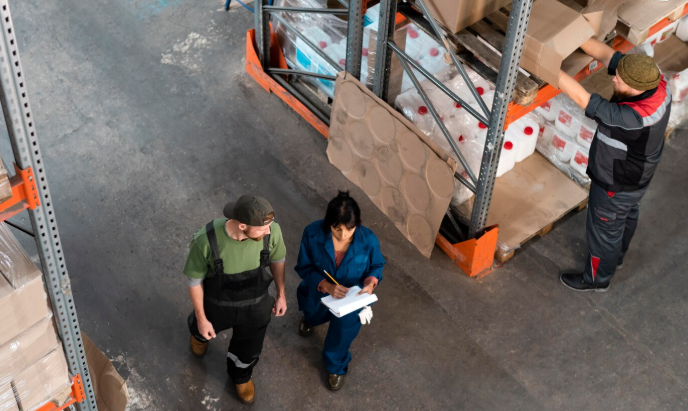How to Build a Continuous Improvement Culture in Warehouse Operations

In warehouse operations, standing still is the same as falling behind. Supply chains are becoming more complex, customer expectations are rising, and competition is getting tougher. The most successful warehouses aren’t just efficient today—they’re continuously finding ways to be better tomorrow.
That mindset is called continuous improvement, and it’s more than a process—it’s a culture.
In this post, we’ll explore what continuous improvement means for warehouses, why it matters, and the practical steps you can take to make it part of your team’s everyday routine.
What Is Continuous Improvement in Warehousing?
Continuous improvement (often linked to Lean, Kaizen, and Six Sigma methodologies) is the ongoing process of identifying, implementing, and sustaining small, incremental changes that lead to better performance.
In a warehouse context, this could mean:
- Reducing picking errors
- Improving space utilization
- Shortening order cycle times
- Streamlining safety checks
The goal is not a one-time project but an ongoing commitment to operational excellence.
Why Continuous Improvement Matters in Warehouse Operations
Here’s why a culture of improvement is a game-changer for warehouses:
- Adaptability to Change
Market demands, technology, and customer preferences shift constantly. A continuous improvement mindset ensures your warehouse evolves with them.
- Employee Engagement
When staff are empowered to suggest changes, they take ownership of results and feel more valued.
- Operational Efficiency
Small, consistent enhancements can lead to significant cost savings and productivity gains over time.
- Customer Satisfaction
Fewer errors, faster deliveries, and consistent quality all contribute to happier customers.
Steps to Build a Continuous Improvement Culture in Your Warehouse
Creating this culture isn’t just about introducing new tools—it’s about changing how people think, work, and collaborate.
Step 1: Start with Leadership Commitment
Continuous improvement must be championed from the top. Leaders should not only support but also actively participate in improvement initiatives. When employees see leadership taking part in floor walks, reviewing KPIs, and recognizing contributions, they’ll know improvement is a shared priority.
Tip: Host monthly improvement meetings where leaders review progress and share success stories.
Step 2: Set Clear, Measurable Goals
Improvement without direction can become unfocused. Define SMART goals (Specific, Measurable, Achievable, Relevant, Time-bound) for key performance areas like order accuracy, cycle time, or equipment downtime.
Example:
- Reduce picking errors from 2% to 1% in the next 6 months.
- Increase order fulfillment speed by 15% within the next quarter.
Step 3: Empower Employees to Identify Issues
Your warehouse operators, pickers, and packers are closest to the action—they see inefficiencies first-hand. Encourage them to speak up when they spot problems or opportunities for improvement.
How to do it:
- Introduce a “suggestion box” (physical or digital).
- Reward implemented ideas with small incentives or recognition.
- Involve employees in process-mapping exercises to uncover bottlenecks.
Step 4: Use Data to Drive Decisions
Guesswork leads to inconsistent results. Use warehouse KPIs and analytics to pinpoint where improvements are most needed.
Key metrics to monitor:
- Order Accuracy Rate – Are customers receiving exactly what they ordered?
- Inventory Turnover – Are items moving efficiently through your warehouse?
- Space Utilization – Is every square foot being used effectively?
Data not only highlights problem areas but also tracks the impact of improvement efforts over time.
Step 5: Train for Continuous Learning
Improvement isn’t possible without the right skills. Provide training in Lean principles, WMS usage, safety protocols, and problem-solving techniques.
Training Ideas:
- Cross-train employees so they can work in multiple areas.
- Host quarterly workshops on warehouse technology and best practices.
- Use “lunch and learn” sessions to share quick process tips.
Step 6: Implement Small, Incremental Changes
Don’t try to overhaul your warehouse overnight. Focus on small, manageable improvements that can be tested, refined, and scaled.
Example:
- Reorganizing one high-traffic picking zone for better flow.
- Changing labeling formats to speed up scanning.
- Adding visual cues (floor markings, signage) to reduce navigation time.
Over time, these small wins add up to major gains.
Step 7: Recognize and Celebrate Success
Recognition is fuel for improvement. Acknowledge individuals and teams that contribute to positive changes.
Ways to celebrate:
- Highlight achievements in team meetings.
- Offer “Improvement Champion” awards.
- Post before-and-after photos of process changes on a warehouse bulletin board.
Common Obstacles—and How to Overcome Them
Even with the best intentions, building a continuous improvement culture comes with challenges.
- Resistance to Change
Solution: Involve employees early, explain the “why” behind changes, and show quick wins to build trust. - Lack of Time
Solution: Integrate improvement discussions into existing workflows rather than adding extra meetings. - Insufficient Data
Solution: Invest in reliable warehouse management software to capture accurate warehouse metrics and make them accessible to decision-makers.
Real-World Example: Kaizen in Action
A mid-sized distribution center implemented a Kaizen board where employees could post process improvement ideas. In six months, they had implemented over 40 changes, including reorganizing storage areas, adjusting shift schedules, and introducing better picking carts.
The result?
- 20% increase in picking efficiency
- 15% reduction in workplace accidents
- Higher employee morale and participation in improvement programs
The Long-Term Payoff
A continuous improvement culture doesn’t just optimize today’s operations—it prepares your warehouse for tomorrow’s challenges. You’ll be better equipped to adopt new technologies, adjust to market changes, and maintain a competitive edge.
Think of it as compounding interest: small daily improvements can lead to massive results over time.
Final Thoughts
Building a continuous improvement culture in warehouse operations requires commitment, communication, and consistency. By engaging employees, using data effectively, and celebrating wins, you create an environment where progress becomes second nature.
In warehousing as in life, small steps taken consistently lead to big results. Start today, and watch your warehouse evolve into a hub of innovation and efficiency.



